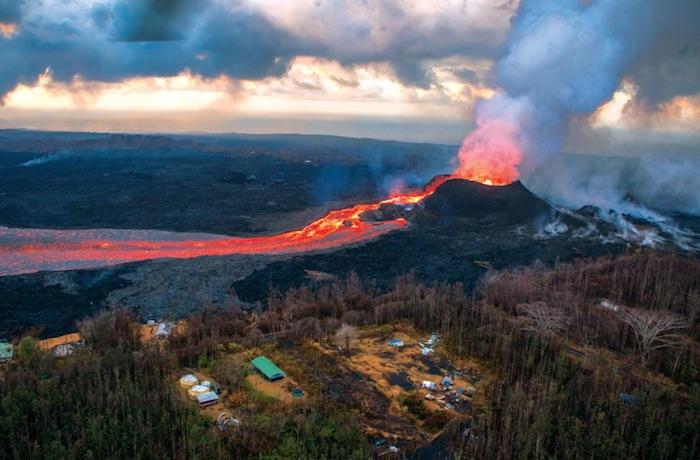
Lava fountains and channelized flow erupting from the Fissure 8 spatter cone along Kilauea’s Lower East Rift Zone in the Leilani Estates subdivision, lower Puna, Hawai’i, on June 25, 2018/Ben Gaddis, USGS
Have you visited Hawai'i National Park and gotten close to the Kīlauea Volcano, enjoyed Paradise at Mount Rainier National Park, climbed to the top of Lassen Peak in its namesake park, or hiked down to Crater Lake? If so, you've placed yourself in the midst of some of the country's most dangerous volcanoes in terms of the threats they pose, according to the U.S. Geological Survey.
The latest U.S. Geological Survey National Volcanic Threat Assessment, an update to the 2005 assessment, places volcanoes into five threat categories: very low, low, moderate, high, and very high.
Volcanic threat, as defined by Ewert (2007), is the combination of 24 factors describing a volcano’s hazard potential and exposure of people and property to those hazards (independent of any mitigation efforts or actions). Prompted by the growing global recognition of airborne volcanic ash to enroute aviation, the 2005 U.S. threat assessment was the first time that hazards to aviation had been taken into account in any national-scale volcanic hazard or risk assessment and prioritization schema. The 24-factor threat assessment was designed to account for the highly variable knowledge of the eruptive histories of the more than 160 active U.S. volcanoes, and the diversity of eruptive styles and geographic settings of U.S. volcanoes, as well as to be easily understood by nonspecialists.
According to the U.S.G.S., 34 of the volcanic systems (about 21 percent overall) mentioned in the assessment are either entirely or partially within areas managed as national parks or national monuments (two of the monuments are managed by agencies other than the National Park Service). Within the National Park System, the following park locations made the list:
Hawai'i Volcanoes National Park, for Kīlauea (No. 1 overall, very high threat) and Mauna Loa (No. 16, very high threat).
Mount Rainier National Park, a park established around an active volcano (No. 2, very high threat).
Lake Clark National Park and Preserve, which claims Illiamna Volcano (No. 20, high threat) and Redoubt Volcano (No. 4, very high threat).
Lassen Volcanic National Park, Lassen Peak (No. 11 overall, very high threat)
Crater Lake National Park, which is established around an active volcano (No. 17 overall, very high threat).
Yellowstone National Park, which surrounds the Yellowstone caldera (No. 21, high threat)
Aniakchak National Monument, home to the Aniakchak Crater (No. 22, high threat).
Katmai National Park and Preserve, which claims Mount Martin (No. 25, high threat), Mount Mageik (No. 26, high threat), Trident Volcano (No. 27, high threat), Novarupta (No. 37, high threat), Mount Griggs (No. 42, high threat), Mount Katmai (No. 28, high threat), Snowy Mountain (No. 52, high threat), Mount Denison (No. 87, moderate threat), Mount Steller (No. 88, moderate threat), Kukak Volcano (No. 66, moderate threat), Kaguyak Crater (No. 43, high threat), Fourpeaked Mountain (No. 53, high threat), Mount Douglas (No. 54, high threat).
Wrangell-St. Elias National Park and Preserve, home to the Mount Wrangell (No. 101, moderate threat) and Mount Churchill (No. 38, high threat) volcanoes.
Lava Beds National Monument, where Medicine Lake lies (No. 45, high threat)
Valles Caldera National Preserve, which includes a volcanic caldera (No. 68, moderate threat)
Sunset Crater National Monument, which is located within the San Francisco Volcanic Field (No. 80, moderate threat)
Haleakala National Park, for its namesake volcano (No. 86, moderate threat)
Death Valley National Park, for Ubehebe Crater (No. 99, moderate threat)
Craters of the Moon National Monument, (Hells Half Acre, Black Butte Crater, Wapi Flow, No. 124, low threat)
El Malpais National Monument, for the Zuni-Bandera volcanic field (No. 141, low threat).
Devils Postpile National Monument, which is home to Mammoth Mountain (No. 151, very low threat)




 Support Essential Coverage of Essential Places
Support Essential Coverage of Essential Places







Add comment